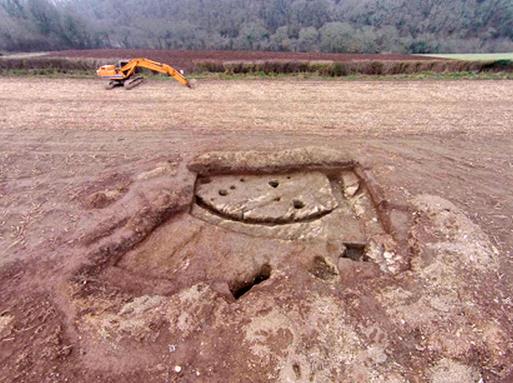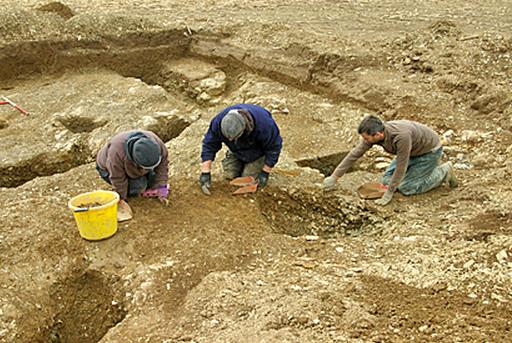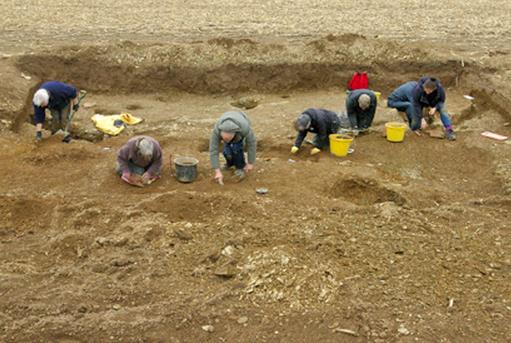Devon fields could have been prehistoric camp and Romano-British roundhouse
From:culture24.org.uk NetWriter:Date:2015-03-20
Two-week dig in Spriddlestone proves triumphant after detectorist sparks search of fields.After a dig launched to culminate years of theorising by Howard Jones, a local archaeologist and former Royal Marine whose suspicions were strengthened by Google Maps, archaeologists are about to compile their findings from a set of four riverside fields near Plymouth which could have been part of one of Devon’s oldest settlements.

A drone image of the roundhouse - shown by a ditch curving round - and several internal post-holes in Spriddlestone
A wealth of artefacts from the Roman and medieval periods have already been identified since the two-week initial phase of the dig ended last weekend. Having made his way across the fields in pursuit of convincing preparatory evidence, Jones found receptive allies in the form of rugby club hosts, volunteers from local history and archaeology societies and local newspaper the Western Morning News.
“It all went very well,” says Dr Sam Wells, of Southwest Archaeology, the group which is now sifting through the sherds.
“The weather was relatively kind – cold but mostly dry. The Plymstock Oaks Rugby Club facilities were liberally given, without which the project could not have happened.

The farmer of the fields helped volunteers by opening the trenches
“The site is at an inconvenient location in terms of enabling wider public access, but having a publically accessible base with a large car park allowed for wider public engagement and worked out well for visitors.
“We had a range of volunteers turn up, some of whom travelled long distances to be involved, from Middlesex and Wiltshire. But most were local – from Plymouth and South Devon.
“The finds from the field walking include a good assemblage of flints, from the Mesolithic to Early Bronze Age.
“There are plenty of post-medieval and later pottery sherds and an amazing amount of small medieval sherds - South Devon Wares and St Germans Wares - most likely derived from Spriddlestone House.
“There were a small number of sherds of 15th and 16th century luxury imported pottery types, which may support them being of high-status origin, prior to being spread on the fields, presumably with the rest of the domestic rubbish, as manure.”

The weather was cold but dry for the alliance of groups taking part
The farmer who owned the land was “co-operative and interested”, opening all five productive trenches by machine and gladly extending one later in the process.
“The most interesting of the trenches revealed part of a late Iron Age or Romano-British roundhouse which had been cut into the hillside,” says Wells.
“This house appears to relate to the ‘final’ phase of settlement on the site, and had in fact cut - overlay and partly truncated - a ditch associated with the settlement enclosures identified on the geophysics.
“This suggests that we have at least two phases of Iron Age settlement on the site, and that the first phase, or at least parts of it, had gone out of use long enough for the ditches to largely silt up and be forgotten prior to the second phase being constructed.

All of the excavated features appear to come from the Iron Age
“All of the excavated features appear to have been of Iron Age date, but within the excavations and from the fieldwalking and metal detecting finds there is enough evidence to suggest that there had been a phase of Bronze Age activity - possibly field systems and settlement - on the site.
“It could also have been utilised during the later stone age, both in the Mesolithic and Neolithic periods, perhaps as a temporary or seasonal camp. They were certainly on site long enough to make flint tools – lots of debitage, flint waste flakes.”
The team, which includes a retired archaeologist who oversaw the field walking, are hoping to carry out a season of work next year if they can secure more funding.
“The results have proved very good, and the preservation on the site also appears good,” says Wells.
“The next stage is to tabulate all the finds, count, weigh and clean them.
“Various specialists in flint, metalwork and pottery will then be involved in assessing the pottery forms and dates – particularly the prehistoric material.
“Many of the fieldwalking finds - like modern pottery and brick - will be discarded following tabulation and weighing.
“Several choice assemblages will be compiled in order to create display cases for the Rugby Club, Plymstock Library and possibly local schools if they would like them.
“The stratified finds - recovered during the excavations rather than field walking - will end up in Plymouth Museum.”
Wells will be giving talks to local societies and helping to produce leaflets and booklets about the findings once the report is published later this year.

